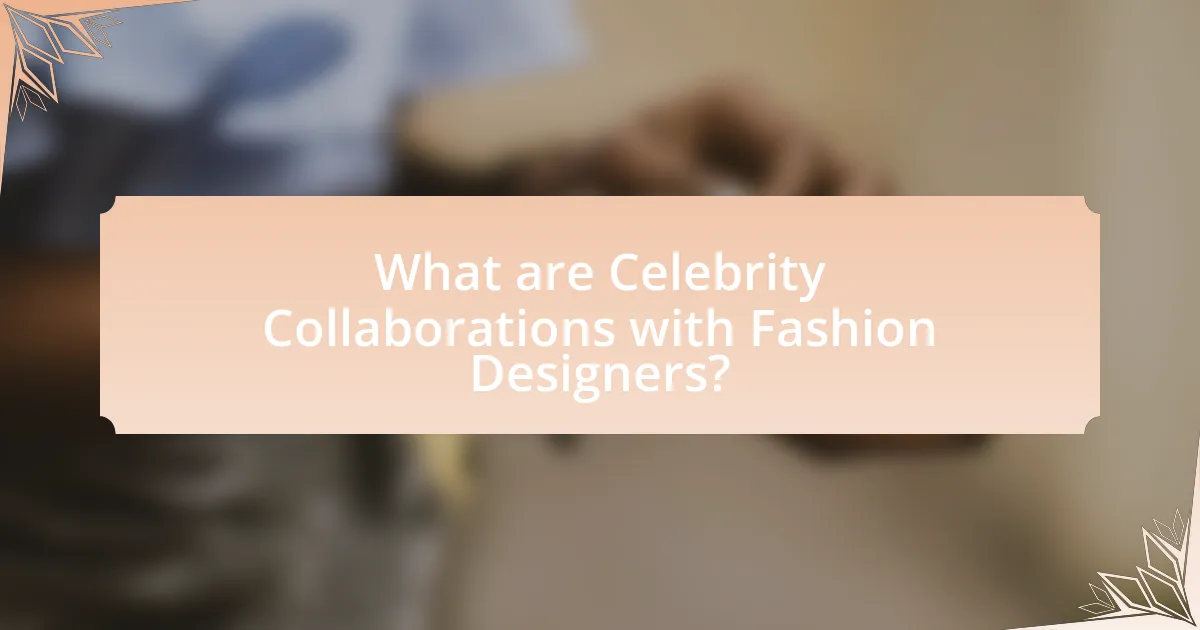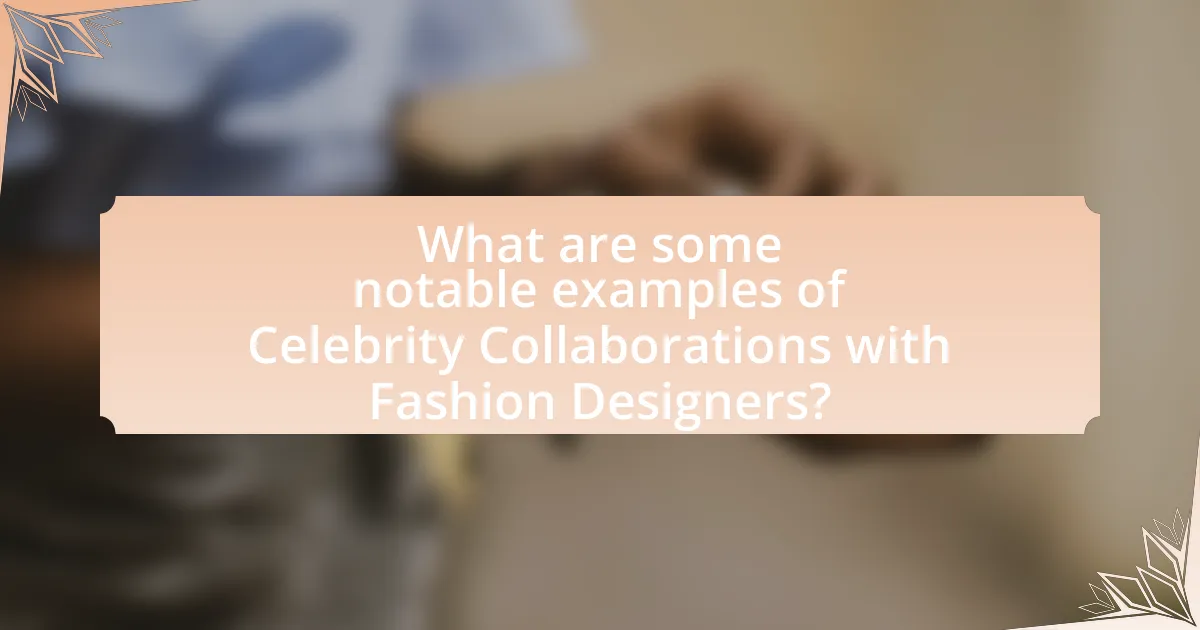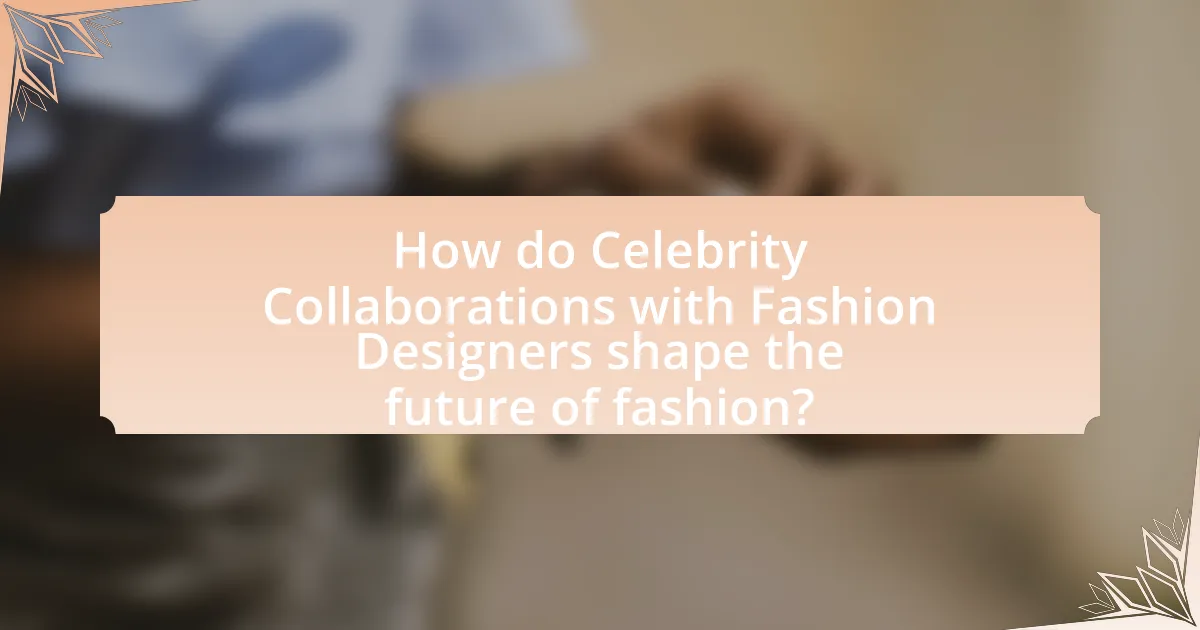Celebrity collaborations with fashion designers represent strategic partnerships where influential figures work with designers to create exclusive clothing lines. These collaborations enhance brand visibility and consumer engagement, as seen in successful partnerships like Rihanna’s Fenty x Puma and Kanye West’s Yeezy with Adidas. The article explores how these collaborations emerge, the roles celebrities play in the design process, the benefits for designers, and the significant impact on consumer trends and brand visibility. It also addresses the evolution of these partnerships, challenges faced, and emerging trends such as sustainability and inclusivity, providing practical tips for successful collaborations.

What are Celebrity Collaborations with Fashion Designers?
Celebrity collaborations with fashion designers are partnerships where well-known individuals work with designers to create exclusive clothing lines or collections. These collaborations often leverage the celebrity’s influence and fan base to enhance brand visibility and appeal. For instance, Rihanna’s collaboration with Puma resulted in the highly successful Fenty x Puma line, which significantly boosted Puma’s market presence. Similarly, Kanye West’s Yeezy brand, developed in partnership with Adidas, has become a cultural phenomenon, generating billions in revenue. Such collaborations not only merge celebrity style with designer expertise but also create unique products that resonate with consumers, driving sales and brand loyalty.
How do these collaborations typically come about?
Collaborations between celebrities and fashion designers typically arise through mutual interest and strategic partnerships. Celebrities often seek to expand their brand and influence within the fashion industry, while designers look to leverage the celebrity’s visibility to enhance their own brand recognition. This synergy is frequently facilitated by talent agencies, public relations firms, or direct outreach, where both parties identify shared goals and creative visions. For instance, the collaboration between Rihanna and Puma in 2014 was initiated by Rihanna’s desire to create a unique fashion line, which aligned with Puma’s strategy to revitalize its brand image through celebrity endorsements.
What roles do celebrities play in the design process?
Celebrities play multiple roles in the design process, primarily as influencers, collaborators, and brand ambassadors. Their influence can drive trends and consumer interest, as seen when Rihanna’s collaboration with Puma revitalized the brand’s image and increased sales by 20% in 2015. Additionally, celebrities often collaborate directly with designers, contributing their personal style and vision, which can lead to unique collections that resonate with fans. For instance, Kanye West’s partnership with Adidas resulted in the highly successful Yeezy line, which generated over $1 billion in revenue in 2019. Lastly, as brand ambassadors, celebrities enhance marketing efforts, leveraging their social media platforms to reach vast audiences, thereby amplifying the visibility and desirability of the designs.
How do fashion designers benefit from celebrity partnerships?
Fashion designers benefit from celebrity partnerships primarily through increased brand visibility and credibility. When a celebrity endorses or collaborates with a designer, it often leads to heightened media attention and consumer interest, significantly boosting sales. For instance, a study by the NPD Group found that celebrity endorsements can increase sales by up to 20% for fashion brands. Additionally, these partnerships can enhance a designer’s reputation, as celebrities often bring their own fan base and influence, creating a perception of exclusivity and desirability around the designer’s products.
Why are these collaborations significant in the fashion industry?
Collaborations between celebrities and fashion designers are significant in the fashion industry because they drive innovation, enhance brand visibility, and create unique consumer experiences. These partnerships often result in limited-edition collections that generate buzz and excitement, leading to increased sales and brand loyalty. For instance, the collaboration between Rihanna and Puma revitalized the brand, resulting in a reported 20% increase in sales during the first year of their partnership. Additionally, such collaborations often merge diverse cultural influences, pushing creative boundaries and appealing to a broader audience, which is crucial in a competitive market.
What impact do celebrity collaborations have on brand visibility?
Celebrity collaborations significantly enhance brand visibility by leveraging the star power and reach of well-known figures. When a brand partners with a celebrity, it gains access to the celebrity’s audience, which can lead to increased awareness and engagement. For instance, a study by the Harvard Business Review found that brands collaborating with celebrities can experience up to a 20% increase in brand recognition and a 10% boost in sales within the first few months of the collaboration. This impact is attributed to the celebrity’s influence and the media coverage that such partnerships typically generate, amplifying the brand’s presence in the market.
How do these partnerships influence consumer trends?
Celebrity collaborations with fashion designers significantly influence consumer trends by creating heightened brand visibility and desirability. These partnerships often leverage the celebrity’s influence and fan base, leading to increased consumer interest and engagement with the brand. For instance, when a well-known celebrity collaborates with a designer, it can result in a spike in social media mentions and searches for the brand, as seen with Rihanna’s collaboration with Puma, which led to a 30% increase in sales for the brand during the partnership period. This phenomenon illustrates how celebrity endorsements can shape consumer preferences and drive purchasing behavior, ultimately altering market dynamics in the fashion industry.

What are some notable examples of Celebrity Collaborations with Fashion Designers?
Notable examples of celebrity collaborations with fashion designers include Rihanna’s partnership with Puma, which resulted in the successful Fenty x Puma line, and Beyoncé’s collaboration with Adidas, leading to the Ivy Park collection. Additionally, Kanye West’s Yeezy brand, developed in collaboration with Adidas, has significantly impacted streetwear culture. These collaborations have not only generated substantial revenue but also influenced fashion trends globally, showcasing the powerful intersection of celebrity influence and designer creativity.
Which celebrities have made a significant impact in fashion collaborations?
Rihanna has made a significant impact in fashion collaborations, particularly through her Fenty Beauty line and partnerships with brands like Puma and Savage X Fenty. Her collaboration with Puma revitalized the brand’s image and increased sales by 30% in the first year. Additionally, Kanye West’s Yeezy line with Adidas transformed sneaker culture and generated over $1 billion in revenue, showcasing the power of celebrity influence in fashion. Other notable figures include Beyoncé, whose Ivy Park collaboration with Adidas has been praised for its inclusivity and innovation, and Pharrell Williams, whose work with Adidas and Moncler has pushed boundaries in streetwear and luxury fashion.
What are the most successful celebrity fashion lines?
The most successful celebrity fashion lines include Rihanna’s Savage X Fenty, which generated over $1 billion in revenue since its launch in 2018, and Kanye West’s Yeezy, known for its high demand and resale value, with estimates of over $1.5 billion in sales. Other notable lines are Jessica Simpson’s fashion brand, which has earned over $1 billion in sales since its inception, and Beyoncé’s Ivy Park, which has received significant acclaim and commercial success. These brands exemplify the lucrative potential of celebrity collaborations in the fashion industry, supported by strong marketing and brand loyalty.
How have these collaborations evolved over time?
Celebrity collaborations with fashion designers have evolved from simple endorsements to complex partnerships that influence trends and brand identities. Initially, celebrities primarily served as brand ambassadors, promoting products through advertisements. Over time, these collaborations have transformed into co-creation ventures, where celebrities actively participate in the design process, resulting in unique collections that reflect their personal style. For instance, the partnership between Rihanna and Puma, which began in 2014, exemplifies this evolution; Rihanna not only endorsed the brand but also contributed to the design of the Fenty line, leading to significant commercial success and cultural impact. This shift highlights a growing trend where celebrities leverage their influence to shape fashion narratives, creating a more interactive and dynamic relationship between celebrities and designers.
What challenges do celebrities and designers face in collaborations?
Celebrities and designers face several challenges in collaborations, primarily stemming from differing creative visions and brand identities. These discrepancies can lead to conflicts over design direction, as celebrities often have personal styles that may not align with the designer’s aesthetic. Additionally, logistical issues such as production timelines and budget constraints can complicate the collaboration process. For instance, a celebrity may desire a quick turnaround for a collection to coincide with a promotional event, while a designer may require more time to ensure quality and craftsmanship. Furthermore, the pressure of public scrutiny can create stress, as both parties must navigate consumer expectations and media attention. These challenges highlight the complexities inherent in merging celebrity influence with fashion design expertise.
How do differing creative visions affect the collaboration process?
Differing creative visions can significantly complicate the collaboration process by leading to misunderstandings and conflicts among team members. When celebrities and fashion designers have contrasting ideas about aesthetics, branding, or target audiences, it can result in a lack of cohesion in the final product. For instance, a celebrity may prioritize personal style and public image, while a designer might focus on artistic expression and innovation. This divergence can hinder effective communication and decision-making, ultimately affecting the project’s success. Research indicates that successful collaborations often require alignment in vision and goals, as seen in partnerships like Rihanna and Puma, where shared creative direction led to a cohesive and successful collection.
What are common pitfalls in celebrity fashion partnerships?
Common pitfalls in celebrity fashion partnerships include misalignment of brand values, lack of clear communication, and overexposure. Misalignment occurs when the celebrity’s personal brand does not resonate with the fashion label’s identity, leading to consumer confusion and diminished authenticity. For instance, when a celebrity known for casual wear partners with a luxury brand, it may alienate their existing fan base. Lack of clear communication can result in misunderstandings regarding design direction, marketing strategies, and target demographics, which can derail the collaboration. Overexposure happens when a celebrity endorses too many brands simultaneously, diluting their impact and making their partnership with a fashion label feel less special. These pitfalls can significantly hinder the success of the collaboration, as evidenced by various high-profile partnerships that failed to achieve their intended market impact.

How do Celebrity Collaborations with Fashion Designers shape the future of fashion?
Celebrity collaborations with fashion designers significantly shape the future of fashion by driving trends, expanding market reach, and influencing consumer behavior. These partnerships often result in unique collections that blend celebrity aesthetics with designer craftsmanship, creating buzz and excitement in the fashion industry. For instance, Rihanna’s collaboration with Puma revitalized the brand and led to a surge in sales, demonstrating how a celebrity’s influence can elevate a designer’s visibility and appeal. Additionally, such collaborations often leverage social media platforms, allowing for rapid dissemination of styles and trends, which can lead to immediate consumer demand. This dynamic not only sets new fashion standards but also encourages designers to innovate and adapt to the evolving tastes of a celebrity-driven market.
What trends are emerging from recent collaborations?
Recent collaborations between celebrities and fashion designers are increasingly characterized by a focus on sustainability and inclusivity. Many high-profile partnerships are now prioritizing eco-friendly materials and ethical production practices, reflecting a growing consumer demand for responsible fashion. For instance, brands like Stella McCartney have collaborated with celebrities such as Emma Watson to promote sustainable fashion, highlighting the importance of environmental consciousness in the industry. Additionally, collaborations are embracing diverse body types and cultural representations, as seen in the work of Rihanna with Savage X Fenty, which emphasizes inclusivity in sizing and representation. These trends indicate a significant shift towards socially responsible and diverse fashion collaborations.
How are sustainability and ethical considerations influencing these partnerships?
Sustainability and ethical considerations are significantly influencing celebrity collaborations with fashion designers by driving the demand for eco-friendly materials and responsible production practices. Celebrities, as influential figures, are increasingly advocating for sustainable fashion, which encourages designers to adopt practices that minimize environmental impact, such as using organic fabrics and reducing waste. For instance, brands like Stella McCartney have gained recognition for their commitment to sustainability, aligning with celebrities who prioritize ethical consumption. This shift is supported by consumer trends, where 66% of global consumers are willing to pay more for sustainable brands, highlighting the market’s response to these ethical considerations.
What role does social media play in promoting these collaborations?
Social media plays a crucial role in promoting celebrity collaborations with fashion designers by providing a platform for immediate visibility and engagement. Through platforms like Instagram and Twitter, celebrities can share their collaborations directly with millions of followers, generating buzz and excitement. For instance, when Rihanna launched her Fenty Beauty line, social media was instrumental in creating a viral marketing effect, leading to a reported $100 million in sales within the first 40 days. This demonstrates how social media not only amplifies reach but also drives consumer interest and sales in celebrity fashion collaborations.
What practical tips can celebrities and designers follow for successful collaborations?
Celebrities and designers can achieve successful collaborations by establishing clear communication and shared goals from the outset. This ensures that both parties understand each other’s vision and expectations, which is crucial for aligning creative ideas. Additionally, conducting thorough market research can help identify trends and consumer preferences, allowing the collaboration to resonate with the target audience. For instance, the collaboration between Rihanna and Puma successfully combined her personal style with the brand’s identity, resulting in a highly popular product line. Regular feedback loops during the design process can also enhance the collaboration, enabling adjustments based on each party’s insights.
How can effective communication enhance collaboration outcomes?
Effective communication enhances collaboration outcomes by ensuring clarity, alignment, and mutual understanding among team members. When individuals involved in a collaboration, such as celebrities and fashion designers, communicate effectively, they can articulate their visions, expectations, and feedback clearly, which minimizes misunderstandings and fosters a productive working environment. Research indicates that teams with strong communication practices are 25% more productive, as they can quickly resolve conflicts and adapt to changes in project direction. This increased productivity directly contributes to successful collaboration outcomes, leading to innovative and cohesive fashion designs that resonate with audiences.
What strategies can be employed to align creative visions?
To align creative visions in celebrity collaborations with fashion designers, establishing clear communication is essential. This involves regular discussions to ensure both parties understand each other’s artistic goals and expectations. Additionally, creating a shared vision board can visually represent ideas and inspirations, facilitating a cohesive direction. Research indicates that successful collaborations often include structured brainstorming sessions, allowing for the integration of diverse perspectives while maintaining a unified theme. Furthermore, setting specific milestones and deadlines can help track progress and ensure alignment throughout the creative process.